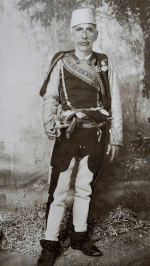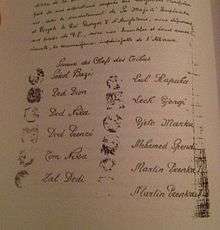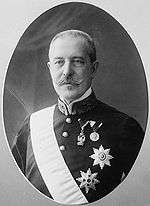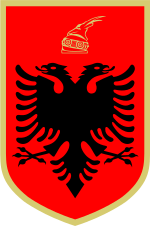Albanian revolt of 1911
The Albanian revolt of 1911[1] or the Malësori uprising of 1911[2] was one of many Albanian revolts in the Ottoman Empire and lasted from 24 March 1911 until 4 August 1911 in the region of Malësia.[3]
| Albanian revolt of 1911 | |||||||
|---|---|---|---|---|---|---|---|
 Depiction of the revolt by The Illustrated Tribute (April, 1911) | |||||||
| |||||||
| Belligerents | |||||||
|
|
| ||||||
| Commanders and leaders | |||||||
| Şevket Turgut Paşa |
Ded Gjo Luli Sokol Baci Mehmet Shpendi | ||||||
| Strength | |||||||
| 8,000 | Unknown | ||||||
Background

The main headquarters of the rebels were in Podgorica and King Nikola provided weapons for the insurgents.[4] King Nicholas promised to support Malissori with arms and to provide a shelter to their families before the revolt began.[5]
Although both king Nikola and prince Danilo were assuring Ottoman ambassador that they are observing "the strictest neutrality" it was obvious that Kingdom of Montenegro was involved in this revolt. General Vukotić organized passing out the weapon to the rebels.[6] The fighting of the Malisori tribes was directed by Vukotić.[7]
Nikola's strategy was to stimulate unrest in northern Albania and north-western Kosovo to the point where he could intervene and annex more territory for Montenegro.[8] Most of contemporary studies confirm that this uprising was supported by Montenegro.[9][10][11]
During Albanian Revolt of 1910 many Albanian refugees found shelter in Montenegro. They were a heavy burden for Montenegro whose souvereign stated that Montenegro spent more than its annual budget to support the Albanian refugees.[12]
At the end of March 1911 the Kingdom of Montenegro forced them to return to Kosovo Vilayet.[13] Thousands of refugees together with the Albanian Catholic tribes staged the Albanian Revolt of 1911.[14]
The Albanian National Committee was founded in Podgorica in February 1911.[15] In a meeting of the Committee held in Podgorica from 2 to 4 February 1911, under the leadership of Nikolla bey Ivanaj and Sokol Baci Ivezaj, it was decided to organize an Albanian uprising.[16]
Revolt in Malësia
Revolt
Troops of Montenegro supported the revolt and captured 12 Ottoman soldiers and imprisoned them in Podgorica.[17]
The first serious attempt of the Ottoman government to suppress the revolt resulted with the Battle of Deçiq. Terenzio Tocci gathered the Mirdite chieftains on 26 April 1911 in Orosh, proclaimed the independence of Albania, raised the flag of Albania (according to Robert Elsie it was raised for the first time after Skanderbeg's death) and established the provisional government.[18] Shefqet Turgut Pasha wanted to meet this threat and returned to the region with 8.000 soldiers. As soon as he reached Shkodër on 11 May, he issued a general proclamation which declared martial law and offered an amnesty for all rebels (except for Malisori chieftains) if they immediately return to their homes.[19] After Ottoman troops entered the area Tocci fled the empire abandoning his activities.[20]
On 14 May, three days after his proclamation, Shefqet Turgut Pasha ordered his troops to seize Dečić, hill that overlooked Tuzi.[21] Sixty Albanian chieftains rejected Turgut Pasha's proclamation on their meeting in Podgorica on 18 May.[22] After almost a month of intense fightings rebels were trapped and their only choices were either to die fighting, to surrender or to flee to Montenegro.[23] Most of the rebels chose to flee to Montenegro which became a base for large number of rebels determined to attack the Ottoman Empire.[24] Ismail Kemal Bey and Tiranli Cemal bey traveled from Italy to Montenegro at the end of May and met the rebels to convince them to adopt the nationalistic agenda which they eventually did.[25][26] On 12 June Porte prematurely proclaimed that the revolt had ended.[27]
Gerče Memorandum
At initiative Ismail Qemali[28] the assembly of the tribal leaders of the revolt was held in a village in Montenegro (Gerče) on 23 June 1911 to adopt the "Gerče Memorandum" (sometimes referred to as "Red Book" because of the color of its covers[29]) with their requests both to Ottoman Empire and Europe (in particular to the Great Britain).[30] This memorandum was signed by 22 Albanian chieftains, four from each tribe of Hoti, Grude and Skrel, five from Kastrati, three from Klementi and two from Shale.[31]

Requests of memorandum included:[32]
- general amnesty for all participants in the revolt
- demand for recognition of the Albanian ethnicity
- election of the deputies of Albanian ethnicity for the Ottoman Parliament according to the proportional system
- Albanian language in schools
- governor and other appointed high officials have to know Albanian language and all other positions in the administration have to be reserved only for people of Albanian ethnicity
- men who are ethnic Albanians to serve army only in Albania during the peacetime
- confiscated arms to be returned
- all Albanian property damaged by Ottoman troops to be compensated
The Memorandum was submitted to the representatives of Great Powers in Cetinje, Montenegro.[33] It was basically a reply to amnesty offered by Ottoman military commander Shefqet Turgut Pasha.[34]
Activities of the Great Powers

At the end of May 1911 Russia protested against military moves of Ottoman army near the border of Montenegro and sent a note to the Ottoman foreign minister.[35] Russian Empire was very willing to participate in efforts to resolve the crisis because it was afraid that Austria-Hungary might increase its influence in Montenegro and use the crisis to invade and annex Albania.[36] Serbia and Italy also believed that Austria-Hungary was responsible for the revolt in Albania and suspected that Austria had plans to intervene in Albania.[37][38] The British ambassador in Vienna rejected the possibility that Austria-Hungary caused the revolt.[39]
On 8 June, von Aehrenthal, the foreign minister of Austria-Hungary, issued a semi-official note to the Ottoman Empire[40] and informed the Porte that Ottoman repression of the Catholic tribes will not be ignored and in case it is continued Austria-Hungary will take an action.[41] Austrian intervention to support the rebels was urged by Catholic journals in Vienna as well.[42]
Failed attempts to organize revolt in the north and south Albania
The Albanian revolts in the period before the First Balkan War were organized mostly in the region of Malësia. Isa Boletini, one of the leaders of the Albanian insurgents in Kosovo vilayet, wrote a proclamation on 23 March 1911 to the Albanians in the south to join Albanians from the Kosovo vilayet in their uprising. He sent his emissaries on 15 April 1911 to pass his proclamation to the southern insurgents.[43] One of the main tasks of the Black Society for Salvation was to organize uprisings in the southern territories.[44] The members of the society organized a meeting in Kolonjë. The meeting was attended by the emissaries from the Kosovo vilayet who brought the proclamation of Isa Boletini.[45] The leaders of the society decided in that meeting to organize groups of armed rebels and to launch the uprising in the south in early June 1911.[46] The society managed to establish committees in several towns including Korçë, Elbasan, Debar and Ohrid, but it failed to maintain control over them because each committee acted on its own direction.[47]
Suppression of the revolt
After the Battle of Deçiq Ottoman government decided for peaceful means of suppression of the revolt because frequent clashes with Albanians attracted the attention of the European Great Powers.[48]
On 11 June sultan Mehmed V visited Skopje where he was greeted enthusiastically by the local population together with two Albanian chieftains who swore their allegiance to the Ottoman sultan.[49] On 15 June, the date of the Battle of Kosovo, he visited the site of the historical battle greeted by 100.000 people. During his visit to Kosovo vilayet he signed a general amnesty for all participants of the Albanian revolts of 1910 and 1911.[50] He was welcomed by the choir of the Serbian Orthodox Seminary with Turkish songs and vice-consul Milan Rakić had gathered a large contingent of Serbs, but many Albanians boycotted the event.[51]
Ottoman representatives managed to deal with the leaders of Albanian rebels in Kosovo Vilayet and Scutari Vilayet separately, because they were not united and lacked central control.[52] The Ottoman Empire first managed to pacify the northern Albanian malësorë (highlanders) from Scutari Vilayet reaching a compromise during a meeting in Podgorica. In order to resolve the problems in the south, the Ottoman representatives invited Albanian southern leaders to a meeting in Tepelenë on 18 August 1911. They promised to meet most of their demands, like general amnesty, the opening of Albanian language schools, and the restriction that military service was to be performed only in the territory of the vilayets with substantial Albanian population. Other demands included requiring administrative officers to learn the Albanian language, and that the possession of weapons would be permitted.[53]
Aftermath
The Albanian Revolt of 1911 stimulated Turkish nationalism because it proved that it was impossible to maintain the unity of the population of the Ottoman Empire even in the case of a Muslim community.[54] Montenegrin king Nikola composed a poem The Uprising of Malisores (Serbian: Малисорски устанак 1911) in honor of this uprising.[55]
See also
- Albanian Revolt of 1910
- Tringe Smajl Martini
- Albanian Revolt of 1912
- Sokol Baci
Notes
- Crampton, R J (1980), The hollow detente: Anglo-German relations in the Balkans, 1911–1914, London: Prior, pp. 36, 50, ISBN 978-0-391-02159-4, OCLC 16497526,
..."Albanian revolt of 1911"
- Treadway 1983, p. 74
The Malësori Uprising of 1911
- Gurakuqi, Romeo, The Highland Uprising of 1911, Shkodra: University of Shkodra "Luigj Gurakuqi" – Department of History, archived from the original (php) on 6 October 2011, retrieved 6 October 2011,
The uprising went on from 24 March 1911, to 4 August 1911.
- Vickers 1999, pp. 63, 64
... Podgorica became the headquarters of the insurgents, due to support the Albanians received from King Nicholas of Montenegro... who ensured they got the weapons...
- (Kondis 1977, p. 99): ""The Malissori Uprising of 1911 and Greek-Albanian Negotiations in the United States for a Secret ... Before the uprising King Nicholas of Montenegro had promised the Malissori arms and refuge for their families""
- Treadway 1983, p. 75
Nicholas assured the Ottoman ambassador that his government was observing "the strictest neutrality" while his eldest son claimed that "we Montenegrins most sincerely desire peace". Despite these denials, it became increasingly clear that Montenegro did have a hand in the new revolt. In particular general Vukotić aided the rebels by passing out weapons, which the Malissori used against Turks.
- (Stojančević 1990, p. 178): "... General Vukotić... was also directing the fightings of Malesoret rebels..."
- Malcolm, Noel (1998). Kosovo: A short history. Washington Square, New York: New York University Press. pp. 242. ISBN 0-8147-5598-4.
But his basic strategy, clearly, was the same as before: to stimulate unrest in northern Albania and north-western Kosovo, to the point where he could intervene and annex more territory for Montenegro.
- Études balkaniques. Édition de lA̕cadémie bulgare des sciences. 2002. p. 49.
In the opinion of foreign observers, reproduced in most of the contemporary studies, the Malesori uprising in the spring of 191 1 was inspired by Montenegro.
- Skënder Anamali (2004). Historia e Shqipërisë, Vellimi 2. Akademia e Shkencave e RPS të Shqipërisë, Instituti i Historisë. p. 423.
- Stavro Skendi (2015). The Albanian National Awakening. Princeton University Press. p. 413. ISBN 9781400847761.
- (Stojančević 1990, p. 187):"Newspapers wrote that the Malesoret uprising had cost Montenegro more than a four-month war. Talking to the correspondent of the Viennese New Free Press, King Nikola said that the Albanians had cost Montenegro over four million perpers and that everything in the country was at a standstill (it should be mentioned that the budgetary revenue planned for 1911 was 3,983,132 perpers).
- Akmeşe 2005, p. 99
... yet another revolt took place at the end of March 1911, when Kingdom of Montenegro forced the mountain people who had taken refugee there, to return across the frontier
- Vickers 1999, p. 63
In March 1911 the Catholic tribes together with the thousands of refugees from Kosova who had fled to Montenegro, staged a general insurrection
- "Historia e Malesisë". Malesia.org. Retrieved 3 March 2011.
dhe mbas themelimit të Komitetit Nacional Shqiptarë në Podgoricë në shkurt 1911 në krye të së cilit vëndoset Sokol Baci Ivezaj dhe që drejtohej nga Nikollë Ivanaj...
- "Historia e Malesisë". Malesia.org. Retrieved 3 March 2011.
Në mbledhjen e Podgoricës (2–4 shkurt 1911) do të vëndoset që kryengritja do të fillojë me sigurimin e armës, afer Shën Gjergjit.
- Treadway 1983, p. 75
Montenegrin troops also captured twelve Turkish soldiers on their own initiative and took them to Podgorica
- Elsie, Robert (2004), Historical dictionary of Albania, Lanham, Md.: Scarecrow Press, p. 444, ISBN 978-0-8108-4872-6, OCLC 52347600,
Tocci Torenzio....On 26 April 1911 he gathered the chieftains of Mirdita near Orosh and proclaimed independence of Albania, hoisting the Albanian flag for the first time after the death of Skanderbeg
- Gawrych 2006, p. 186
- Gawrych 2006, p. 186
- Treadway 1983, p. 77
government called upon Shefqet Turgut Pasha...on 11 May he proclaimed martial law...On the third day however, the impatient general ordered his troops to seize the important hill of Dečić overlooking Tuzi.
- Treadway 1983, p. 77
In they Podgorica declarationof 18 May sixty Albanian chiefs rejected Turgut's demands...
- Treadway 1983, p. 77
During the month of intense fighting...By the end of June the Catholic insurgents jointed by the powerful Mirdite clans, were trapped...They had but three choices left to them: to surrender, to die where they were or to flee across the border into Montenegro.
- Treadway 1983, p. 77
Most chose the last option. Once again became a haven for large body of insurgent forces determined to make war on Ottoman Empire.
- Études balkaniques. Édition de lA̕cadémie bulgare des sciences. 2002. p. 49.
The memorandum adopted at a general assembly in Gerçë a month later doubtless bears the penmanship of Ismail Qemali, who arrived in Montenegro from Italy at the end of May.
- Gawrych 2006, pp. 186, 187
Meanwhile Ismail Kemal and Tiranli Cemal Bey personally visited rebellious Malisors in Montenegro to encourage them to accept a nationalistic program.... The Ghegs of Iskodra had embraced nationalistic program.
- Treadway 1983, p. 77
... the Turkish government prematurely announced on 12 June, that the revolt was over
- Isaković, Antonije (1990). Kosovsko-metohijski zbornik. Srpska akademija nauka i umetnosti. p. 298.
У то време стигао je у Црну Гору албански нрвак Исмаил Кемал Bej да би се састао са главарима побушених Малисора. На н>егову инищцативу дошло je до састанка побунэених Малисора у селу Герче у Црно) Гори.
- Skendi, Stavro (1967). The Albanian national awakening, 1878–1912. Princeton University Press. p. 417. Retrieved 10 October 2011.
The Gerche memorandum, referred to often as "The Red Book" because of the color of its covers
- Treadway 1983, p. 78
- Gawrych 2006, p. 187
Twenty two Albanians signed the memorandum, including four each from the fises of Grude, Hoti and Skrel; five from Kastrati; three from Klement, and two from Shale
- Gawrych 2006, p. 187
The demands included a guarantee of immunity from punishment for all Albanians, the recognition of "the national existence of Albanians",... selecting Albanian deputies ...according to the principle of proportional representation...Albanian language in ... schools, ...
- Mikić, Đorđe (1983). Austro-Ugarska i Mladoturci: 1908-1912. Institut za istoriju u Banjaluci. p. 273.
У исто време су Албанци емигранти у Црној Гори, на челу са Исмаилом Кемалом и Луибијем Гуракућијем, образложили своје захтеве под називом »Меморандум из Герче« или »Црвена књига« и предали их представницима великих сила на Цетињу.
- Bartl, Peter (2001) [1995], Albanci: od srednjeg veka do danas (in Serbian), translated by Ljubinka Milenković, Belgrade: Clio, p. 131, ISBN 9788671020176, OCLC 51036121, retrieved 1 February 2012
- Shaw, Albert (1911), Review of reviews and world's work, The Review of Reviews Corporation, p. 118
- Bridge 1972, p. 332
...Russians so anxious to keep in touch... they were afraid that Austrians, if left to themselves might assume the role of sole protectors of Montenegro , or even exploit the crisis to invade and annex Albania.
- Treadway 1983, p. 75
Serbia still blamed Aehrenthal for the "Albanian troubles" and Italy doubted the sincerity of the foreign ministers pledges of nonintervention in Albanian imbroglio.
- Todorov, Kosta (1938), Politička istorija savremene Bugarske, Belgrade: Štamparija "Sloga" D.G. Popoviča, p. 187, OCLC 17609156,
"Ове устанке изазивала је Аустрија у циљу да изненади балканске државе интервенцијом у Албанији" [Revolts were caused by Austria with aim to surprise Balkan countries with its military intervention in Albania]
- Treadway 1983, p. 76
The British ambassador in Vienna, however, rightly discounted the possibility of Austrian government's having encouraged the rebellion in any way...
- Bridge 1972, p. 332
...on 8 June the semi-official Fremdenblatt carried a summons to the Young Turks to put their house in order.
- Vickers 1999, p. 64
Eventually, Austria Hungary,..., let the Porte know that she could no longer ignore the savage repression of the Catholic tribes and would have to take action if this continued.
- The Independent, 70, The Independent Publications, incorporated, 1911, p. 1037,
The Catholic papers of Vienna are vehemently urging Austrian intervention in favor of the Malissori Christian tribes
- Gazmend Shpuza (1984). "Rilindja Kombëtare Shqiptare: Shpërthimi i Kryengritjes Dhe Veprimet Luftarake (Mars – Fillimi i Qershorit 1911)". Archived from the original on 24 July 2011. Retrieved 21 February 2011.
Më 15 prill 1911 përfaqësues të Kosovës çuan në viset jugore thirrjen që Isa Boletini e kishte lëshuar disa kohë më parë (më 23 mars) nga malet e Shqipërisë, në të cilën thuhej: “
- "Përgatitja e kryengritjes" [Preparation of the uprising] (in Albanian). Archived from the original on 18 February 2011. Retrieved 18 February 2011.
Këtu u vendos të shpejtohej organizimi i çetave dhe në fillim të qershorit të niste kryengritja edhe në jug të vendit.
- Gazmend Shpuza (1984). "Rilindja Kombëtare Shqiptare: Shpërthimi i Kryengritjes Dhe Veprimet Luftarake (Mars – Fillimi i Qershorit 1911)". Archived from the original on 24 July 2011. Retrieved 21 February 2011.
Në Kolonjë u mbajt një mbledhje e udhëheqësve të lëvizjes, ku morën pjesë edhe emisarët kosovarë që sollën letrën e Isa Boletinit.
- Gazmend Shpuza (1984). "Rilindja Kombëtare Shqiptare: Shpërthimi i Kryengritjes Dhe Veprimet Luftarake (Mars – Fillimi i Qershorit 1911)". Archived from the original on 24 July 2011. Retrieved 21 February 2011.
Këtu u vendos të shpejtohej organizimi i çetave dhe në fillim të qershorit të niste kryengritja edhe në jug të vendit.
- Ermenji, Abas (1968). "Vendi Që Zë Skënderbeu Në Historinë e Shqiperisë". Retrieved 22 February 2011.
Me këtë qëllim u formua në jugë një organizatë e fshehtë, e quajtur "Shoqëria e Zezë për Shpëtim", e cila desh të merrte drejtimin e lëvizjes, dhe krijoi disa degë aty-këtu, por nuk arriti dot t'a bashkonte as t'a kumandonte vepërimin e shpërndarë të çetavet
- Akmeşe 2005, p. 99
As perpetual clashes between Albanians and Ottoman government were attracting European attention, the Ottoman government turned to peaceful means.
- Gawrych 2006, p. 189
- Gawrych 2006, p. 189
- Malcolm, Noel (1998). Kosovo: A short history. Washington Square, New York: New York University Press. pp. 244. ISBN 0-8147-5598-4.
...he was welcomed by the choir of the Serbian Orthodox Seminary, serenading him with Turkish songs; vice-consul Rakić had gathered a large contingent of Serbs, but the Albanians of many areas of Kosovo boycotted the event.
- Ermenji, Abas (1968). "Vendi Që Zë Skënderbeu Në Historinë e Shqiperisë". Retrieved 22 February 2011.
Turqit të bënin marrëveshje krahinore të veçanta me kryengritësit si në vitin 1911.
- Ermenji, Abas (1968). "Vendi Që Zë Skënderbeu Në Historinë E Shqiperisë". Retrieved 22 February 2011.
Por n'atë kohë u muarën vesh propozimet e reja që po iu bënte qeveria turke malësorëvet të Mbishkodrës t'arratisur në Podgoricë...Premtimet ishin pak më të gjera nga ato që iu qenë bërë malësorëvet të Mbishkodrës, sepse parashikohej një falje e përgjithshme, hapja e shkollave shqipe me ndihmën financiare të shtetit dhe mësimi i shqipes në shkollat turqishte. Taksat do të caktohëshin sipas gjendjes së popullit, shërbimi ushtarak do të kryhej në vilajetet shqiptare, nëpunësit e administratës duhej të dinin gjuhën dhe zakonet e vendit, armët mund të mbahëshin me lejë.
- Akmeşe 2005, p. 99
- Simpozijum oslobodilacki pokreti jugoslovenskih naroda od XVI veka do pocetka Prvog Svetskog Rata. Branko Bajid. 1976. p. 318.
Устанку Албанаца краљ Никола је посветмо спјев Малисорски устанак 1911...
References
- Treadway, John D (1983), "The Malissori Uprising of 1911", The Falcon and Eagle: Montenegro and Austria-Hungary, 1908–1914, West Lafayette, Ind.: Purdue University Press, ISBN 978-0-911198-65-2, OCLC 9299144, retrieved 10 October 2011CS1 maint: ref=harv (link)
- Gawrych, George Walter (2006), The crescent and the eagle: Ottoman rule, Islam and the Albanians, 1874–1913, London: I.B. Tauris, ISBN 1-84511-287-3CS1 maint: ref=harv (link)
- Vickers, Miranda (1999). The Albanians: a modern history. I.B.Tauris. pp. 63, 64. ISBN 978-1-86064-541-9.
... Podgorica became the headquarters of the insurgents, due to support the Albanians received from King Nicholas of Montenegro... who ensured they got the weapons...
CS1 maint: ref=harv (link) - Akmeşe, Handan Nezir (2005), The birth of modern Turkey: the Ottoman military and the march to World War I, London ; New York: I.B. Tauris, Palgrave Macmillan, ISBN 978-1-85043-797-0, OCLC 60419120CS1 maint: ref=harv (link)
- Bridge, F. R (1972), "Austro-Russian confrontation, 1908 – 1914", From Sadowa to Sarajevo: the foreign policy of Austria-Hungary, 1866–1914, London, Boston: Routledge and K. Paul, ISBN 978-0-7100-7269-6, OCLC 578378CS1 maint: ref=harv (link)
- Stojančević, Vladimir (1990). Srbija i Albanci u XIX i početkom XX veka: ciklus predavanja 10-25. novembar 1987. Srpska akademija nauka i umetnosti.CS1 maint: ref=harv (link)
- Kondis, Basil (1977). Balkan Studies. Institute for Balkan Studies, Society for Macedonian Studies.CS1 maint: ref=harv (link)
Further reading
- Gurakuqi, Romeo, The Highland Uprising of 1911, Shkodra: University of Shkodra "Luigj Gurakuqi" – Department of History, archived from the original (php) on 6 October 2011, retrieved 6 October 2011
- Živojinović, Dragan (1967), "Устанак Малисора 1911. године и америчка помоћ Црној Гори [The Malissori uprising of 1911 and American aid to Montenegro]", Istorijski Zapisi [Historical abstracts], XXIV, Titograd, Yugoslavia: Društvo istoričara SR Crne Gore, pp. 323–338CS1 maint: ref=harv (link)
- James Tallon (2012), The failure of Ottomanism: The Albanian Rebellions of 1909-1912, The University of Chicago
External links
- (in Serbo-Croatian) Đorđe Nikprelević: Velike Sile i Susjedi u Malisorskoj Krizi 1911. Godine
